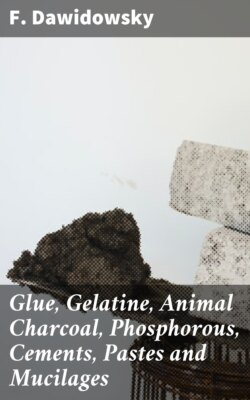Читать книгу Glue, Gelatine, Animal Charcoal, Phosphorous, Cements, Pastes and Mucilages - F. Dawidowsky - Страница 8
На сайте Литреса книга снята с продажи.
4. PROPERTIES OF GLUE AND ITS BEHAVIOR TOWARDS OTHER SUBSTANCES.
ОглавлениеThe product designated by the general term glue, is always a mixture of glutin, chondrin and other substances not yet accurately determined. Glue is formed by evaporating and further drying the jelly, and its properties depend on the crude glue and glue-yielding material used for the production of the jelly.
It may here be remarked that even if the quantity of glutin contained in the different products could not be determined by scientific means, the glue obtained from various materials can be readily distinguished by external characteristics. Every manufacturer knows that hides and bones yield a distinct quality of glue as regards adhesive power, elasticity and fracture, and that the jelly from glue-yielding substances of older animals is more solid and gives a larger yield than that obtained from the tissues of younger and weaker animals. Glue from the bladders and scales of fishes, though consisting mainly of glutin, differs materially from hide or bone glue.
Generally speaking, the jelly, no matter whether consisting of glutin or chondrin, possesses, before drying to glue, different properties from glue solution. It has less adhesive power and spoils more quickly. At a temperature of 68° to 72.5° F., jelly putrefies inside of 24 hours, smells of ammonia, and decomposes, while glue solution can be kept much longer without suffering deterioration.
The jelly absorbs ozone with avidity and is decomposed by it, this being the reason why an approaching thunderstorm may cause great damage by destroying the coagulating power of the glue liquors, or causing the glue to turn on the nets, i.e., to lose its consistency and become liquid and foul.
The behavior of glue solution towards different salts also deserves attention.
By adding potassium or sodium carbonate, neutral potassium tartrate, Rochelle or Epsom salts to a lukewarm fluid containing 15 to 20 per cent. of glue, the latter coagulates by the salt withdrawing the water from it. A lukewarm solution saturated with common salt, sal ammoniac, saltpetre, or barium chloride does not gelatinize.
By adding to glue solution a large quantity of alum, the glue is precipitated as a transparent mass.
Glue compounded at a high temperature with dilute acids, does not gelatinize by itself, but will do so on adding common salt.
Boiling with slaked lime deprives glue solution of its power of gelatinizing, and, on evaporation, changes it into a colorless gummy mass which is soluble in cold water and in saturated solution of common salt.
From a glutin solution compounded with oxalic acid, the latter can after some time be again separated by the addition of lime, the result being a non-gelatinizing fluid which, however, possesses great adhesive power. This is the so-called meta-gelatin.
Glue solution also loses its property of gelatinizing by repeated boiling and cooling (for about six days).
Tannin enters with the jelly, as well as with glue solution, into characteristic combinations which are formed even in solutions containing only 0.005 per cent. of jelly or glue. Glue is, therefore, an excellent agent for the detection of tannin.
When quite concentrated glue solution is treated with tannin, a heavy, flocculent precipitate of a dirty-yellow, caseous character is formed, which turns brown on exposure to the air and, after drying, constitutes a hard brittle mass, easily reduced to powder and soluble in hot potash lye, but insoluble in water, ether and alcohol. This precipitate, if not identical with, is closely allied to the combination of tannin with skin, called leather.
Glue exposed to a dry heat melts, diffuses a strong disagreeable odor of burned horn and leaves behind a charcoal which has a powerful discoloring effect like animal charcoal. When subjected to destructive distillation, glue yields an aqueous solution of ammonium carbonate and a thick brown oil consisting of a mixture of ammonium carbonate, sulphur, ammonium cyanide, etc.
The chemical composition of glue is such as to bring to mind that of starch and cellulose derived from the vegetable kingdom. It contains:
Carbon 49.1 per cent.
Hydrogen 6.5 per cent.
Nitrogen 18.3 per cent.
Oxygen and sulphur 26.1 per cent.
which may be represented by the formula: C12H10N2O4.
The composition of glue differs but little from that of the glue-yielding substance. Isinglass is composed of:
Carbon 49.5 per cent.
Hydrogen 6.9 per cent.
Nitrogen 18.8 per cent.
Oxygen 24.8 per cent.
This justifies the assumption that glue in its various transition stages does not represent different chemical combinations, but only modifications of one and the same combination distinguishable from each other by physical characteristics, as is the case with starch, which without suffering an alteration in its composition, appears as dextrine and grape-sugar, or as with cellulose, which, without altering its composition, can be transformed into amyloid and grape-sugar.
